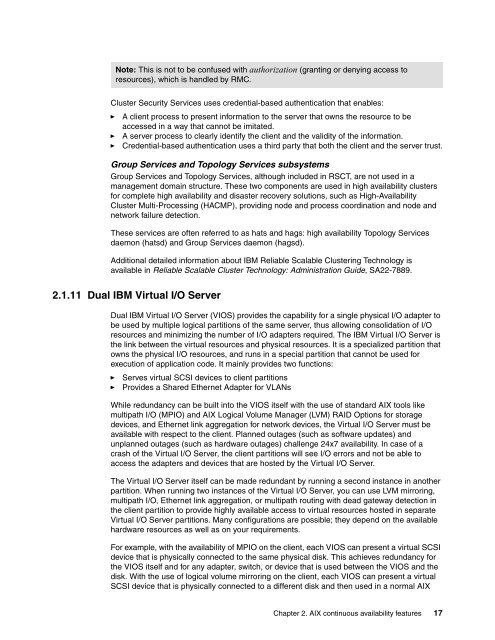IBM AIX Continuous Availability Features - IBM Redbooks
IBM AIX Continuous Availability Features - IBM Redbooks
IBM AIX Continuous Availability Features - IBM Redbooks
Create successful ePaper yourself
Turn your PDF publications into a flip-book with our unique Google optimized e-Paper software.
Note: This is not to be confused with authorization (granting or denying access to<br />
resources), which is handled by RMC.<br />
Cluster Security Services uses credential-based authentication that enables:<br />
► A client process to present information to the server that owns the resource to be<br />
accessed in a way that cannot be imitated.<br />
► A server process to clearly identify the client and the validity of the information.<br />
► Credential-based authentication uses a third party that both the client and the server trust.<br />
Group Services and Topology Services subsystems<br />
Group Services and Topology Services, although included in RSCT, are not used in a<br />
management domain structure. These two components are used in high availability clusters<br />
for complete high availability and disaster recovery solutions, such as High-<strong>Availability</strong><br />
Cluster Multi-Processing (HACMP), providing node and process coordination and node and<br />
network failure detection.<br />
These services are often referred to as hats and hags: high availability Topology Services<br />
daemon (hatsd) and Group Services daemon (hagsd).<br />
Additional detailed information about <strong>IBM</strong> Reliable Scalable Clustering Technology is<br />
available in Reliable Scalable Cluster Technology: Administration Guide, SA22-7889.<br />
2.1.11 Dual <strong>IBM</strong> Virtual I/O Server<br />
Dual <strong>IBM</strong> Virtual I/O Server (VIOS) provides the capability for a single physical I/O adapter to<br />
be used by multiple logical partitions of the same server, thus allowing consolidation of I/O<br />
resources and minimizing the number of I/O adapters required. The <strong>IBM</strong> Virtual I/O Server is<br />
the link between the virtual resources and physical resources. It is a specialized partition that<br />
owns the physical I/O resources, and runs in a special partition that cannot be used for<br />
execution of application code. It mainly provides two functions:<br />
► Serves virtual SCSI devices to client partitions<br />
► Provides a Shared Ethernet Adapter for VLANs<br />
While redundancy can be built into the VIOS itself with the use of standard <strong>AIX</strong> tools like<br />
multipath I/O (MPIO) and <strong>AIX</strong> Logical Volume Manager (LVM) RAID Options for storage<br />
devices, and Ethernet link aggregation for network devices, the Virtual I/O Server must be<br />
available with respect to the client. Planned outages (such as software updates) and<br />
unplanned outages (such as hardware outages) challenge 24x7 availability. In case of a<br />
crash of the Virtual I/O Server, the client partitions will see I/O errors and not be able to<br />
access the adapters and devices that are hosted by the Virtual I/O Server.<br />
The Virtual I/O Server itself can be made redundant by running a second instance in another<br />
partition. When running two instances of the Virtual I/O Server, you can use LVM mirroring,<br />
multipath I/O, Ethernet link aggregation, or multipath routing with dead gateway detection in<br />
the client partition to provide highly available access to virtual resources hosted in separate<br />
Virtual I/O Server partitions. Many configurations are possible; they depend on the available<br />
hardware resources as well as on your requirements.<br />
For example, with the availability of MPIO on the client, each VIOS can present a virtual SCSI<br />
device that is physically connected to the same physical disk. This achieves redundancy for<br />
the VIOS itself and for any adapter, switch, or device that is used between the VIOS and the<br />
disk. With the use of logical volume mirroring on the client, each VIOS can present a virtual<br />
SCSI device that is physically connected to a different disk and then used in a normal <strong>AIX</strong><br />
Chapter 2. <strong>AIX</strong> continuous availability features 17

















